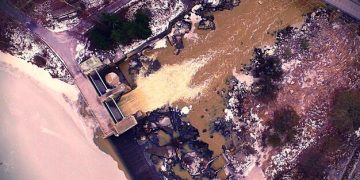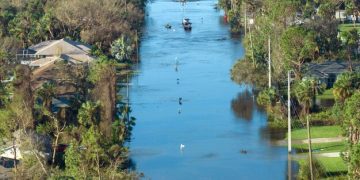US Infrastructure 2025: Flooding & Changing Precipitation Impacts
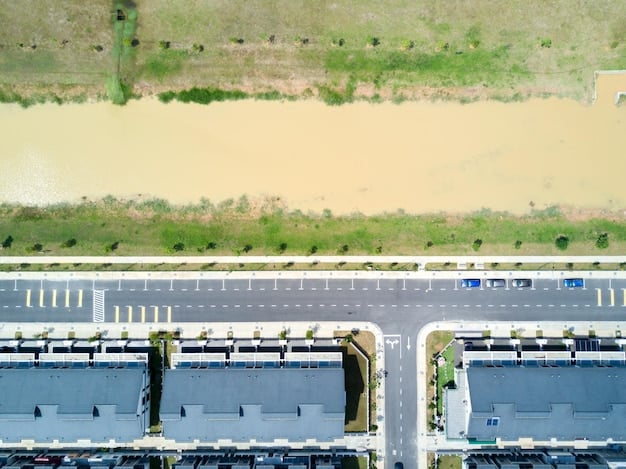
Significant changes in precipitation patterns by 2025 are projected to intensify flooding across the United States, posing unprecedented challenges to critical infrastructure sectors, including transportation, energy, and urban systems, necessitating urgent adaptation and resilience strategies.
As the climate continues its intricate dance of change, one of the most immediate and tangible shifts we are witnessing is in the very fabric of our weather systems. Specifically, changes in precipitation patterns: what impact will increased flooding have on US infrastructure in 2025 is a question that demands our urgent attention. This isn’t a distant hypothetical; it’s a pressing reality already unfolding.
understanding the evolving precipitation landscape
The historical norms for rainfall and snowfall in the United States are giving way to new patterns. Scientists observe a trend towards more extreme precipitation events: fewer, but heavier, downpours. This shift is not uniform across the nation; some regions are experiencing prolonged droughts, while others are grappling with deluges that overwhelm existing drainage systems.
The underlying mechanisms are complex, tied to rising global temperatures that increase atmospheric moisture capacity. A warmer atmosphere can hold more water vapor, leading to intensified rainfall when conditions for condensation are met. This phenomenon contributes significantly to the increased frequency and severity of flash floods and riverine flooding.
regional variations in precipitation shifts
Across the vast and diverse landscape of the U.S., the alterations in precipitation manifest uniquely:
- Coastal areas, particularly in the Southeast and Northeast, face heightened risks from coastal flooding amplified by sea-level rise and more intense rainfall.
- The Midwest is experiencing an increase in heavy downpours, leading to agricultural runoff issues and river flooding.
- The Southwest, while generally drier, experiences more intense but shorter-duration rainfall events that can cause dangerous flash floods in arid landscapes.
- The Pacific Northwest, known for its rain, is seeing shifts in snowpack accumulation, affecting summer water availability and increasing flood risks during rapid thaws.
Understanding these regional nuances is critical for developing localized adaptation strategies, as a one-size-fits-all approach will not suffice against the intricate nature of changing precipitation. The implications for critical infrastructure are profound, requiring a proactive stance rather than a reactive one.
transportation networks: roads, rails, and airports at risk
The circulatory system of the U.S. economy—its transportation infrastructure—is acutely vulnerable to increased flooding. Roads become impassable, railway lines buckle, and airport operations are disrupted, leading to significant economic losses and societal inconveniences. These impacts are not theoretical; they are already occurring with increasing regularity.
Consider the expansive network of highways and local roads that crisscross the nation. Many of these were designed based on historical rainfall data, which is now proving inadequate. Culverts are undersized, drainage systems are overwhelmed, and floodplains that once served as natural buffers are increasingly developed. As little as a few inches of standing water can render roads unusable, trapping commuters and delaying essential deliveries.
vulnerability of vital transportation arteries
The ripple effect of transportation disruptions extends far beyond immediate inconvenience. Supply chains are broken, emergency services struggle to reach those in need, and overall economic productivity declines. The aging nature of much of this infrastructure further exacerbates the problem, as it was not built to withstand the intensity and frequency of current and projected flood events.
- Roadways: Submersion, erosion of roadbeds, and damage to bridges and overpasses.
- Railways: Washouts of tracks, damage to signaling systems, and instability of rail embankments.
- Airports: Flooded runways, damaged terminal buildings, and disruptions to air traffic control systems.
The economic toll from these disruptions can be staggering, encompassing not just direct repair costs but also lost commerce, delayed goods, and reduced tourism. Preparing for 2025 means re-evaluating design standards, investing in resilient materials, and implementing warning systems to minimize the impact of inevitable floods.
energy infrastructure: power grids and fuel lines under threat
A reliable energy supply is the bedrock of a modern society, yet it faces direct threats from altered precipitation patterns and increased flooding. Power grids, from generation plants to transmission lines and local distribution networks, are exposed to various flood-related hazards. Submerged substations, eroded foundations of power lines, and damaged underground cables can lead to widespread and prolonged outages.
The reliance on fossil fuels also means that pipelines and storage facilities are at risk. Flooding can compromise the integrity of pipelines, potentially leading to leaks and environmental contamination. Furthermore, access to critical energy infrastructure for maintenance and repairs becomes severely hampered during flood events, prolonging recovery times.
cascading failures in energy supply
The interconnected nature of the energy system means that a failure in one area can trigger cascading effects. For instance, a flooded power plant could lead to reduced electricity generation, impacting homes, businesses, and critical services like hospitals and water treatment facilities. Similarly, disruptions to fuel delivery can affect transportation, emergency services, and heating, creating a multifaceted crisis.
- Power Plants: Risk of inundation, damage to equipment, and compromised cooling systems.
- Transmission and Distribution: Submerged transformers, damaged poles, and short circuits from standing water.
- Fuel Storage & Pipelines: Erosion of supporting structures, potential for leaks, and contamination.
Building resilience into the energy sector requires strategic foresight, including relocating critical assets to higher ground, fortifying existing structures, and integrating smart grid technologies that can reroute power during localized disruptions. The goal is to minimize not just outages, but also the severity and duration of the recovery period.
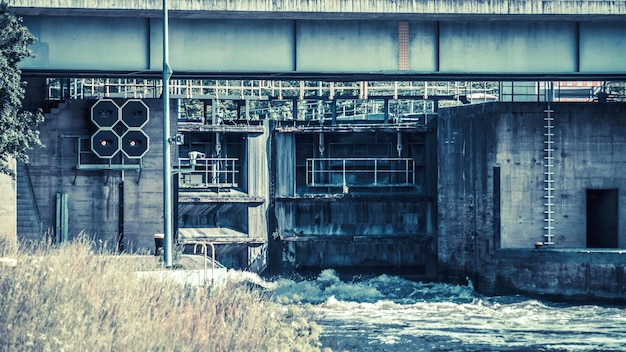
urban systems: water, sanitation, and communication vulnerabilities
Urban centers are complex ecosystems dependent on intricate systems for water, sanitation, and communication. Increased flooding presents a direct challenge to these services, with immediate and often severe consequences for public health and safety. Clean water supplies can be contaminated, wastewater treatment plants overwhelmed, and communication networks disrupted.
When floodwaters mix with sewage, the risk of waterborne diseases escalates dramatically. Moreover, inundated water treatment facilities may struggle to process or distribute potable water, creating a public health emergency. The loss of communication—internet, cellular, and landline services—isolates communities and hampers emergency response efforts, cutting off vital lifelines.
protecting essential urban services
The resilience of urban infrastructure is paramount for a city’s ability to recover from and withstand flood events. Many existing systems were not designed to handle the volume and intensity of modern extreme precipitation. Retrofitting, upgrading, and reimagining urban planning are essential steps to safeguard these critical services.
- Water Supply: Contamination of fresh water sources, damage to pumping stations and filtration plants, and pipe breaches.
- Wastewater Management: Overwhelmed sewer systems leading to overflows, damage to treatment plants, and raw sewage discharge.
- Communication Networks: Submerged junction boxes, damaged fiber optic cables, and power outages affecting cell towers.
Proactive measures include the development of green infrastructure solutions, such as permeable pavements and green roofs, which can help manage stormwater runoff. Hardening essential facilities and creating redundant systems are also crucial. Investing in these areas now can prevent far greater costs and suffering in the future, particularly as 2025 approaches.
economic ramifications and community displacement
Beyond the direct physical damage to infrastructure, increased flooding carries profound economic ramifications and can lead to significant community displacement. Businesses face immediate losses from property damage, inventory destruction, and forced closures. Supply chain disruptions can ripple through entire industries, impacting production and consumer access to goods.
The long-term economic impacts include reduced property values in flood-prone areas, increased insurance premiums, and diverted public funds from other development projects to disaster recovery. For individuals, particularly those in vulnerable communities, the economic burden of rebuilding after a flood can be insurmountable, pushing families into poverty and leading to permanent relocation.
the human cost of infrastructural failure
The human cost of displacement is often overlooked but deeply affecting. When homes are destroyed and livelihoods vanish, communities fracture. Schools close, social networks fray, and the mental health burden on affected individuals can be immense. The loss of community cohesion makes recovery even more challenging.
- Business Losses: Direct property damage, loss of revenue, supply chain disruptions, and increased operating costs.
- Housing Market: Decreased valuations in vulnerable areas, difficulty securing mortgages, and increased foreclosure rates.
- Public Finances: Billions allocated to disaster relief and infrastructure repair, diverting funds from planned investments.
The urgency to address these issues by 2025 stems from the understanding that prevention and resilience building are far more cost-effective than repetitive disaster response. Proactive infrastructure investments can safeguard economic stability and preserve the social fabric of communities.
resilience strategies and adaptation measures for 2025
Given the imminent challenges posed by changing precipitation patterns and increased flooding, a proactive and comprehensive approach to infrastructure resilience is not merely advisable but essential. This involves a multi-faceted strategy encompassing policy changes, technological innovations, and community engagement. The goal is to move beyond simply “building back” to “building forward” with greater strength and adaptability.
Central to these strategies is the adoption of “climate-smart” infrastructure design. This means incorporating future climate projections, not just historical data, into planning and engineering decisions. It also involves prioritizing natural infrastructure solutions, which can often provide more cost-effective and environmentally beneficial flood protection compared to traditional grey infrastructure.
innovative approaches to infrastructure protection
Several key areas are emerging as focal points for building resilience. These approaches combine traditional engineering with ecological principles and advanced data analysis.
- Green Infrastructure: Implementing permeable surfaces, rain gardens, bioswales, and restored wetlands to absorb and manage stormwater naturally.
- Hardening Existing Assets: Elevating critical facilities, installing flood barriers, and reinforcing foundations of essential structures.
- Advanced Monitoring Systems: Utilizing real-time data from weather sensors, satellite imagery, and hydrological models to predict flood events and improve early warning systems.
- Diversification and Redundancy: Creating alternative routes for transportation, backup power systems, and decentralized utility networks to ensure continued service during disruptions.
- Policy and Planning Reform: Updating building codes, land-use zoning, and flood plain management regulations to reflect new climate realities and incentivize resilient development.
Furthermore, effective resilience strategies require dynamic public-private partnerships. Collaboration between government agencies, private industry, academic institutions, and local communities is crucial for pooling resources, sharing knowledge, and implementing large-scale solutions. By 2025, these integrated efforts must be well underway to effectively mitigate the growing risks.
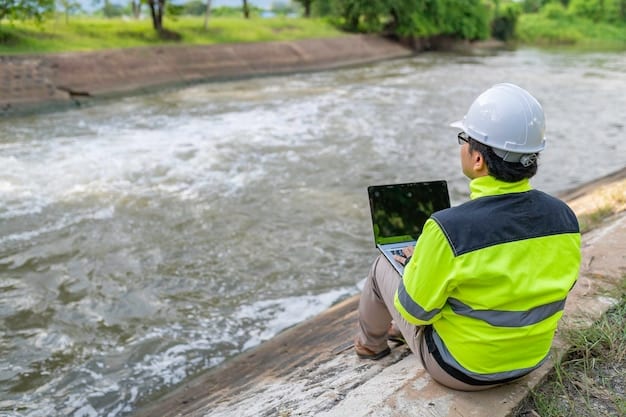
financing the future: investment in flood-resilient infrastructure
The scale of investment required to upgrade and adapt U.S. infrastructure for increased flooding is substantial, but the cost of inaction is far greater. Financing these resilience efforts necessitates innovative funding mechanisms, strategic allocation of resources, and a long-term perspective. Traditional funding models may not be sufficient, prompting a need for creative financial solutions.
Public funds, while critical, must be augmented by private sector investment, leveraging tools like green bonds, resilience bonds, and public-private partnerships. Incentives for private entities to invest in resilient infrastructure and adopt flood-mitigation measures on their properties will be crucial. Furthermore, the insurance industry can play a vital role by adjusting policies to reflect risk accurately and encourage proactive resilience building.
pathways for sustained investment
Securing sustained funding requires demonstrating the clear economic benefits of resilience. Every dollar invested in mitigation can save multiple dollars in damages and recovery costs. Communicating this return on investment to policymakers and the public is key to garnering support for necessary financial commitments.
- Federal and State Grants: Targeted funding programs for infrastructure upgrades, focusing on vulnerable areas and critical assets.
- Bond Issues: Municipal and state bonds specifically for climate adaptation and resilient infrastructure projects.
- Private Sector Investment: Encouraging private capital through tax incentives, regulatory frameworks, and risk-sharing mechanisms.
- International Climate Finance: Exploring opportunities for collaboration and funding from global climate initiatives.
- User Fees and Dedicated Revenue Streams: Implementing new or adjusting existing fees (e.g., stormwater fees) to directly fund resilience projects.
As 2025 approaches, policymakers and industry leaders must actively pursue diversified funding streams and build robust financial frameworks. This will ensure that the necessary investments are made to transform vulnerable infrastructure into resilient systems capable of withstanding the inevitable impacts of changing precipitation patterns and increased flooding, safeguarding the nation’s future.
| Key Aspect | Brief Description |
|---|---|
| 🌊 Changing Patterns | Increased extreme rainfall and shifting regional precipitation norms. |
| 🚨 Infrastructure Threat | Vulnerability of transport, energy, and urban systems to flooding. |
| 📈 Economic Impact | Significant business losses, property devaluation, and increased public costs. |
| 🛡️ Resilience Solutions | Green infrastructure, asset hardening, and proactive policy reforms. |
frequently asked questions
▼
By 2025, increased extreme precipitation events will directly impact U.S. infrastructure by causing more frequent and severe flooding. This will lead to disruptions in transportation (roads, bridges, railways), damage to energy systems (power grids, pipelines), and overwhelmation of urban utilities (water, sanitation, communication), affecting overall operational reliability and integrity.
▼
The most vulnerable infrastructure types include transportation networks like highways, local roads, and rail lines due to inundation and erosion. Energy infrastructure, especially substations and pipelines, faces significant risks from submersion and structural damage. Additionally, urban systems such as wastewater treatment plants, potable water facilities, and communication networks are highly susceptible to flood-related disruptions.
▼
Economic impacts will include substantial direct repair costs, business losses from operational disruptions, and decreased property values in flood-prone areas. Supply chain interruptions will ripple across industries, affecting production and trade. Long-term impacts also involve increased insurance premiums and significant diversion of public funds from other essential services to disaster recovery and infrastructure repair efforts.
▼
Mitigation measures involve implementing climate-smart designs, such as elevating critical infrastructure and using flood-resistant materials. Green infrastructure solutions like permeable pavements and restored wetlands can absorb stormwater. Additionally, improving real-time monitoring and early warning systems, and updating building codes and land-use planning are crucial for building long-term resilience.
▼
Different regions of the US will experience varied impacts. The Northeast and Southeast coasts face increased coastal and pluvial flooding exacerbated by sea-level rise. The Midwest is likely to see more intense riverine flooding from heavy downpours. The Southwest, while drier, will contend with dangerous flash floods, while the Pacific Northwest will face shifts in snowpack impacting summer water and winter flood risks.
conclusion
The trajectory of changing precipitation patterns points unequivocally toward an increase in the frequency and intensity of flooding across the United States. By 2025, the nation’s critical infrastructure — encompassing its vast networks of transportation, energy, and urban systems — will face enhanced strain and vulnerability. The impending impacts are not merely inconveniences; they represent significant threats to economic stability, public health, and community resilience. Addressing this multifaceted challenge demands a concerted and proactive effort, prioritizing advanced planning, innovative adaptation strategies, and substantial investment in durable, climate-resilient infrastructure. The imperative is clear: building a more resilient future requires immediate and sustained commitment to adapt our physical environment to the new realities of a changing climate.

